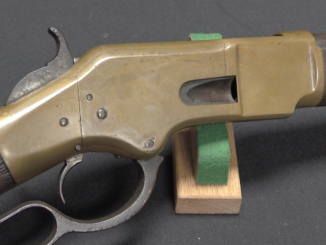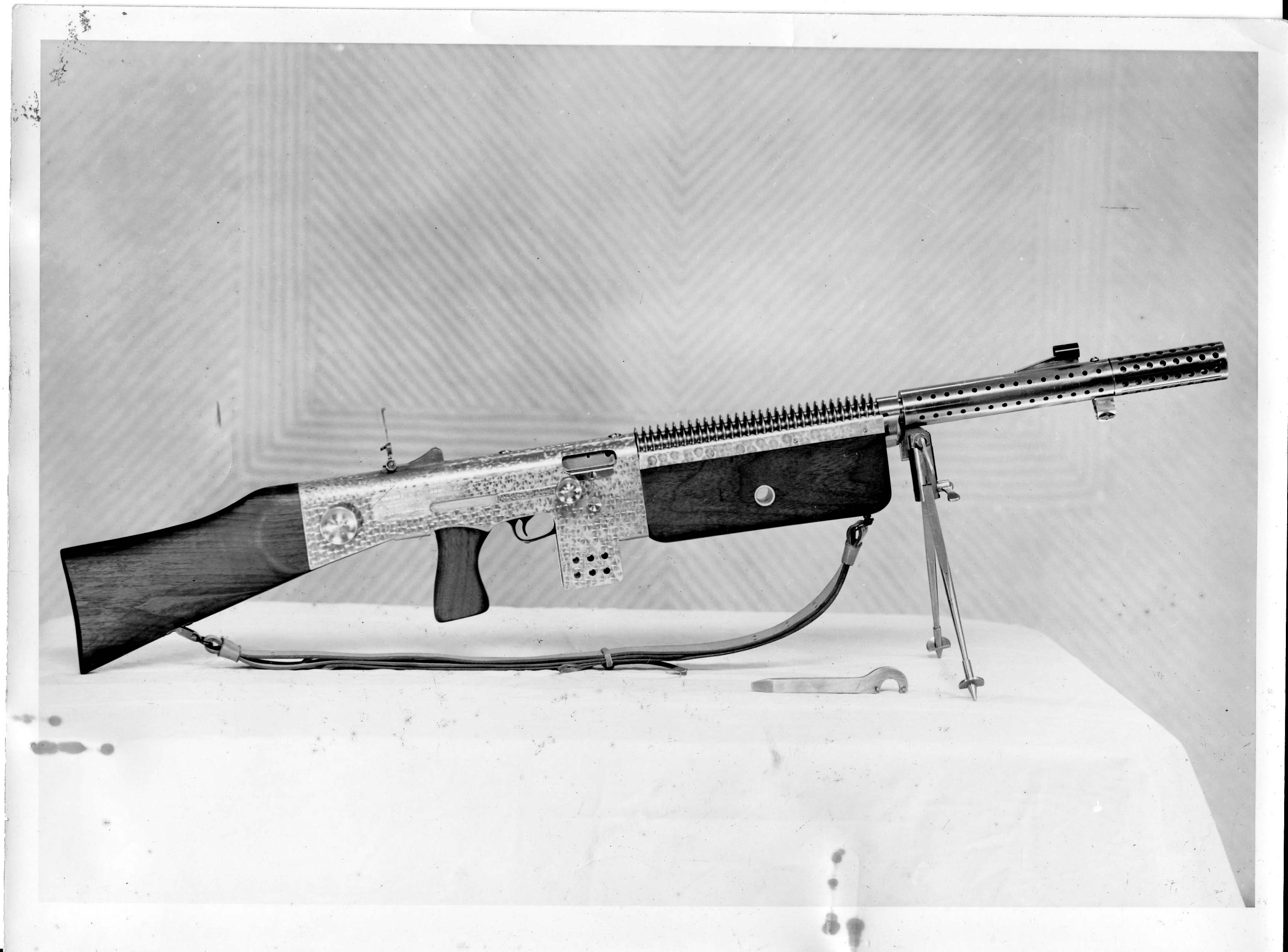This rifle sold for $31,625 at Rock Island on December 1, 2018.
After designing the bolt action rifle that bears his name, Andre Berthier went on to experiment with self-loading designs. He developed a light machine gun in the years before World War One, but was not able to interest the French government in it. He also submitted that gun for US military consideration in 1917, but was similarly rebuffed (in fairness to the militaries, the gun was not really ready for field service). Then the US issued a request for semiautomatic should rifles in 1920, Berthier and his partners at the Vickers company dated the machine gun design into a closed-bolt, semiauto shoulder rifle. After rejection at the May 1920 trials, they redesigned the gas system to be shorter, and resubmitted another rifle to the followup tests in November of 1921. That resubmitted rifle is what we are looking at today.
Internally, the rifle’s design is actually much better than its ungainly external appearance would suggest – but it was still not good enough to interest the US military. The locking system is a two-piece tilting bolt, very similar to the eventually successful Vickers-Berthier light machine gun of the mid 1920s. A firing pin is fixed to the operating rod, and the trigger releases the whole op rod to jump forward under residual mainspring pressure to fire – much like the Lewis and FG42 designs. Clever safety and manual bolt hold open levers double as takedown pins, and the whole system is really quite modern for 1920/21. Unfortunately, the rifle suffered parts breakage and its top-mounted magazine was a major mark against it in US eyes (unfortunately, the magazine itself appears to have been lost since almost immediately after the firing trials).




Wow, very interesting!
Absent any tool room sketches, drawings, or notes or written information from John Cantius Garand–whose primer-actuated self-loading rifle design was not pursued, but sufficiently impressed Ordnance to get him a job at Springfield Armory in Massachusetts–I would be inclined to speculate that some features of this Vickers-Berthier prototype influenced his later prototype submission of the top-feed light rifle/ carbine entry from Springfield Armory?
Note well that the Lewis gun-derived fixed firing pin on the reciprocating gas piston/op-rod, offset front and rear sights, top mounted magazine (well, canted 45 degrees in the top-feed light rifle of 1940 prototype), ease of disassembly, etc. are features found on the prototype two decades later. Of course while this uses a tipping bolt that locks up into a recess/shoulder, the Garand top-feed used a rotating bolt with radially mounted locking lugs, perhaps a bit more like the original Lewis…?
With a few tweaks and refinements, including a wholesale ergonomics revision, with other things like a double-sided firing pin, so if broken it could be turned around and remain in use, captive pins, an improved stock, etc. I could see this as a credible design.
As Ian says, it is fascinating to see these early developments just after WWI. Perhaps someday he can take us “behind the counter” to examine the Sørensen Bang/ Julian Hatcher prototype?
Very interesting. My question is how are these trials rifles showing up for commercial sale? Had thought these were squirrelled away in the Springfield Armory reference collection after the trials. Is the current museum Springfield selling off items? Or were these sold/given away/presented after the initial trials concluded?
In the between-the-wars years, trials weapons were routinely sold off by the War Department when the trials were over. The major reason was that storing them cost money on an annual basis, and in those pacifist days Congress was cutting the WD budget any way they could think of. Also, the revenue from the sales helped paper over some of the shortfalls in that budget.
The Aberdeen Proving Ground Museum did not exist at that time, and when it was started after WW2, one of the things its curators did was advertise for ex-trials weapons for its collection, which they bought from whoever owned them for whatever they and the seller(s) agreed was a fair price. Note that a lot of people simply donated arms and etc. gratis.
I’m guessing they either missed this one or already had a second one.
cheers
eon
“submitted that gun for US military consideration in 1917, but was similarly rebuffed (in fairness to the militaries, the gun was not really ready for field service).”
But not forever, according to https://www.ibiblio.org/hyperwar/USN/ref/MG/I/MG-3.html#14
On its first official trial by the United States Army in May 1917 the gun did not meet requirements. On 29 June of the same year, the Marine Corps after a very comprehensive test, reported it suitable for its use. The Ordnance Board tested the weapon again shortly after the Marine Corps made its report and this later Army board concurred with the Marines, who had again conducted trials that resulted in another favorable report.(…)Contracts were given for the Army’s 5,000 guns. An additional 2,000 were ordered by the Navy for the Marine Corps(…)financial and other complications arose and the parent firm was forced to drop all plans for manufacturing the weapons. As no other source was available that could give any promise of delivery within a reasonable time, all contracts were canceled.
Following up on an idea from the comments section – in the image of possibly-this rifle with the magazine missing, is it possible to tell if the stock is intact there?
A bolt incident could have released pressure into the stock and magazine, damaging both. But you’d think they’d have mentioned an incident of that magnitude in the trials reports.
The offset sights are a bit off-putting to most marksmen, as the usual shooting instinct of long arms is to line up with the barrel of the rifle. To make matters a little more off-putting, just how much ammunition can you carry on your person if we’re talking about detachable magazines which were not treated as expendable during this era?
Could we change the magazine well to feed from the side in the manner of the Heinemann rifle? That might allow centered iron sights. For that matter, add a clip guide to the receiver (to put off the officer’s fear of having no spare magazines in the field). Since the Vickers-Berthier has a proper gas port instead of a gas trap, we won’t have to fear clogging or excessive corrosion from powder residue (so long as the bore and gas cylinder are corrosion resistant). And let’s include a cleaning kit and issue easy-to-understand instruction manuals just to prevent stupidity from making things any worse. Emphasis on READING the entire manual before use, and test the soldiers with one of those tricky quizzes about the manual’s basics before giving them the rifles. If they didn’t read the whole instruction paragraph before they started writing anything (watch for them double-guessing the whole quiz, by the way), you will know they likely TOSSED the manual under the impression that “a gun is any gun is any other gun.” Trust me, some of my freshman classmates in college actually didn’t attend physics lecture and just cram-studied the textbook without understanding the context of the actual materials our professor discussed. They flunked out, for very obvious reasons.
“READING”
But this wouldn’t help if parts are broken due to lack of strength. In military weapons it is important that every part should be durable enough, preferably by whole service life of weapon. Even if easy replacing procedure would be provided I don’t think weapon which would need “change part A after 2193 shots, change part B after 3921 shots, change part C after 4102 shots and so on” procedure would be successful.
“Could we change the magazine well to feed from the side…”
This was my first though when looking at this rifle (in fact pruned-on machine-gun). Magazine on top is not exactly conducive to quick target acquisition, although it makes feed a bit more reliable due to assistance of gravity.
Mr. Berthier was certainly lucky with his French service rifle, but this is clearly a flop.
This concept clearly did not lead to anywhere, but it is unusual and therefore interesting. Thanks for presentation.
Similar might be Farquhar-Hill self-loading rifle and Beardmore-Farquhar machine gun:
http://modernfirearms.net/en/military-rifles/self-loading-rifles/great-britain-self-loading-rifles/farquhar-hill-eng/
http://modernfirearms.net/en/machineguns/great-britain-machineguns/beardmore-farquhar-eng/
although “upside down”, as there machine gun was developed from self-loading rifle. Rifle passed trials and becomes Rifle. .303 inch, Pattern 1918 but war ended before production started, light machine gun failed to attract buyers. There existed .50 version (for 12,7×81 cartridge), which might be called “light heavy machine gun” when compared to other 12,7 mm machine gun of this era, but it also failed to attract buyers.
“concept”
Well, after some consideration “duality” self-loading rifle-(magazine-fed)light machine gun is not so easy to achieve as it might looks at first glance. Requirements are different:
MAGAZINE DIRECTION:
in LMG it is preferably upwards, if possible not downwards*, in self-loading rifle it is preferably downwards, while upwards is unacceptable or at least undesirable
QUICK-CHANGE BARREL
while not MUST HAVE for LMG by inter-war standards it was considered useful, not needed in self-loading rifles, also even if LMG don’t have this feature it would have heavier barrel, which lead to
MASS
for LMG you might except mass under 10 kg (gun itself), for self-loading rifle this would be evidently too much
Finally it might be interested to point AKM – RPK pair here
http://modernfirearms.net/en/machineguns/russia-machineguns/rpk-eng/
although visually similar, RPK and AKM receivers are not identical, among others it has thicker walls, additionally give attention to RPK stock, which is patterned after RPD rather than AKM, as RPK is destined to be mainly used rested on bi-pod.
* this make change be 2 man harder and also mean hard cap on magazine length (unless you accept digging foxhole just for magazine)
Is it just me but without the butt stock does this not loosely resemble a Stoner 63 ?
I can’t help thinking if they had flipped over the weapon’s systems(gas tube above barrel, magazine well on the bottom-BAR style) like the Chatterault FM 24/29 did with the BAR, put a Lewis gun pistol grip behind the trigger group and put a semi-straight line buttstock on it(that covered up that recoil tube)the French/British could have had an FAL by 1930!